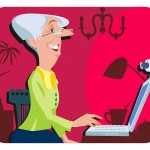We're Not There Yet, Not Even Close
The goal of equality has not been reached.
 We look in the mirrors and see the changes (good, bad, and rarely good from an aging perspective unless there’s been “work done,”) over the last decade. We’ve gotten older (we’ll stipulate that such applies to everyone), perhaps broader (sigh), hopefully wiser (debatable) and a little (or a lot) wealthier (we can dream).
We look in the mirrors and see the changes (good, bad, and rarely good from an aging perspective unless there’s been “work done,”) over the last decade. We’ve gotten older (we’ll stipulate that such applies to everyone), perhaps broader (sigh), hopefully wiser (debatable) and a little (or a lot) wealthier (we can dream).
However, what’s one thing that has barely changed over the past decade? This is not final Jeopardy but perhaps it should be: the percentage of women equity partners in the top 200 law firms.
The National Association of Women Lawyers has released its 2017 survey on promotion and retention of women in law firms and, while not surprising based on many conversations I’ve had with other women lawyers, the results are still disappointing and frustrating:

Early Adopters Of Legal AI Gaining Competitive Edge In Marketplace
1. The more established women’s initiatives are at a firm, the higher the percentage of women equity partners. However, that percentage (nudging close to 20% but not there yet) only confers bragging rights as to firms that have newer initiatives (12%). When NAWL first did its survey in 2007, it found that the percentage of women equity partners was 16%. I don’t even need to use all the fingers on one hand to count the increase in ten years.
2. Even though men and women are hired pretty much equally on the associate level, as the years progress, disparities become more apparent. Women make up 19% of equity partners and 30% of non-equity partners. This even though law schools are cranking out women graduates, and for the first time, women first year law students compose the majority of the incoming classes.
3. If you’re a woman equity partner in a firm that has had an established women’s initiative for some time, then the median earnings for you are 94% of what they are for your male equity partner colleague. Close, but not good enough. However, if the firm is late to establishing a women’s initiative, e.g. only recently, then the woman equity partner earns only 82% of the male equity partner’s earnings. Interview tip: make sure that you find out whether the firm has a women’s initiative and when it was established. Useful intel to factor in when making a career choice.
4. 97% of the firms reported that their top earner is a male (no surprise there) and nearly 70% of the firms have only one or zero, zip, zilch women in the top ten earners. Why is this not a surprise?
Sponsored

The Business Case For AI At Your Law Firm


Is The Future Of Law Distributed? Lessons From The Tech Adoption Curve

Early Adopters Of Legal AI Gaining Competitive Edge In Marketplace

The Business Case For AI At Your Law Firm

5. Remember being at the kids’ table for holiday meals and what it meant to “graduate,” so to speak, to the adults’ table? That was a big deal in my family. So, while women have a “seat at the adults’ table,” so to speak, they don’t have a lot of chairs at that table. There’s some improvement in the number of women who now make up 25% of law firm highest governance roles, compensation committees, managing partner or practice leader. That 25% is nearly double what it was a decade ago. As one of my woman lawyer friends would say, “That’s a big whoop.” Indeed.
6. As dismal as these numbers are for women, they’re worse for people of color, who compose only 6% of equity partners, and women of color make up only 2%. Openly LGBTQ people represent only 2% of equity partners, and people with disabilities represent less than 1%. (So, just what was the purpose of the Americans with Disabilities Act? I would hazard a guess that if lawyers would identify health issues, that number would be higher than one percent, but we all know the stigma attached to self-identification or being outed.)
7. Women equity partners work just as many hours as men, but their billings are 92% of their male colleagues.
Federal Reserve Board Chair Dr. Janet Yellen spoke last spring at her alma mater, Brown University, and talked about the 125 years that women have been in the labor market.
She pointed out that in the 1970s, when I and other dinosaur women lawyers graduated law school, we expected that we would spend the majority of our lives in the work force and we prepared for it, focusing on “…careers as opposed to just jobs.” Ask any lawyer, male or female, and I would think that, to a person, law school students/graduates look at the profession as a career, not just a job, perhaps with the possible exception of document review.
Sponsored

Navigating Financial Success by Avoiding Common Pitfalls and Maximizing Firm Performance

Legal AI: 3 Steps Law Firms Should Take Now
A diverse work force makes business sense, although you wouldn’t know it based on the NAWL survey results. Dr.Yellen pointed out that “A number of studies on how groups perform indicate that workforces that vary on dimensions such as gender, race, and ethnicity produce better decision-making processes and better outcomes.”
Here are some statistics Dr. Yellen mentioned: in 1990, the rate of participation of prime working age women in the United States was 74 percent, higher than all but a few of the industrialized nations. A pop quiz here: by 2010, out of 22 advanced economies with respect to female labor force participation, in what place was the United States? (A hint: we were not in the top half.) We were 17th.
The lack of success in climbing the professional ladder, such as in law, medicine, and Dr. Yellen’s field, economics, can be attributed, to a certain extent, to what is required in these careers: longer workweeks and penalties for taking time off, whether it be for vacation, child care, elder care, or the broad range of non-work responsibilities that fall to women. In our profession, failure to meet billable hours results in damage, both direct monetary loss and collateral reputational risk.
Dr. Yellen’s speech quoted Malala Yousafzai, “We cannot all succeed when half of us are held back.” Couple that with the NAWL 2017 survey results. There is still a lot of “holding back.” Whether dinosaurial or millennial or anywhere in between, women lawyers know all too well what Malala is talking about. It’s like being on that interminable road trip pestering our parents with “are we there yet?” Nope, we’re not even close.
 Jill Switzer has been an active member of the State Bar of California for 40 years. She remembers practicing law in a kinder, gentler time. She’s had a diverse legal career, including stints as a deputy district attorney, a solo practice, and several senior in-house gigs. She now mediates full-time, which gives her the opportunity to see dinosaurs, millennials, and those in-between interact — it’s not always civil. You can reach her by email at oldladylawyer@gmail.com.
Jill Switzer has been an active member of the State Bar of California for 40 years. She remembers practicing law in a kinder, gentler time. She’s had a diverse legal career, including stints as a deputy district attorney, a solo practice, and several senior in-house gigs. She now mediates full-time, which gives her the opportunity to see dinosaurs, millennials, and those in-between interact — it’s not always civil. You can reach her by email at oldladylawyer@gmail.com.







